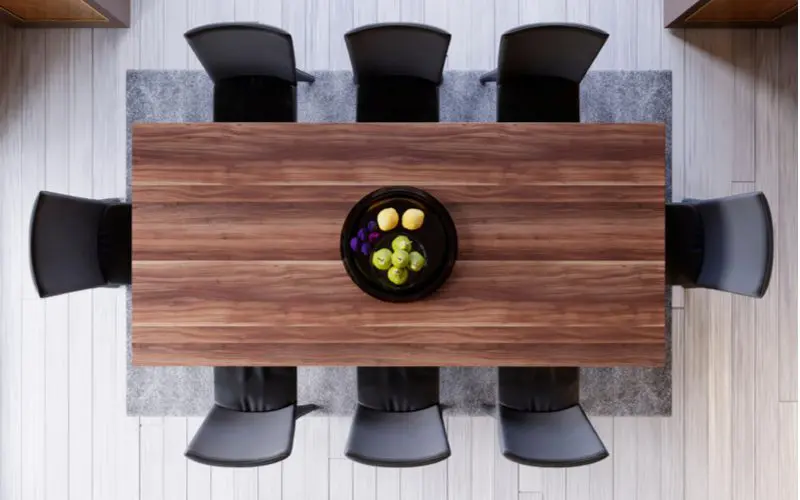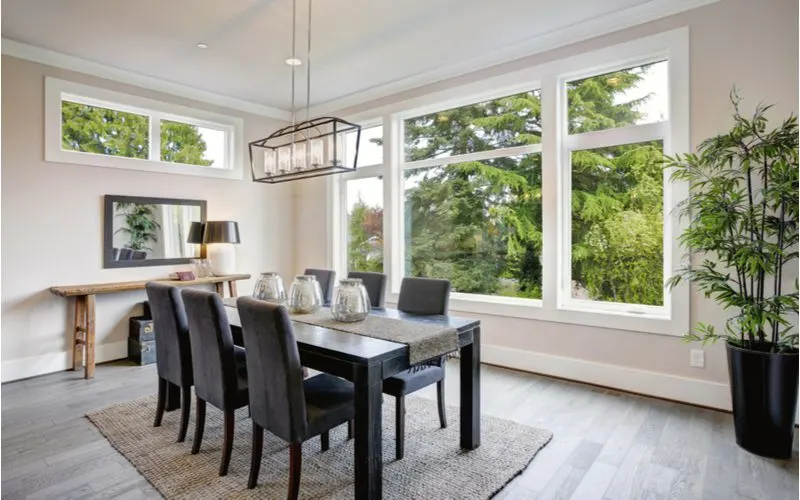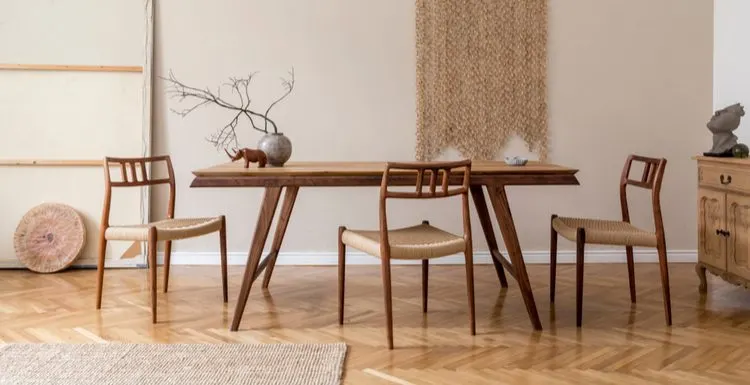Depending on the available space and your wants and needs, your perfect dining table will likely be quite different from someone else’s.
Let’s dive right into standard dining table sizes and everything you need to know to find the right heart for your home.
Dining Table Sizes: The Short Answer
There’s no absolute right or wrong when it comes to dining table sizes. Fitting your space and your purposes is what makes a dining table perfect.
While a height of 28 to 31 inches and a width of 36 to 40 inches are standard across the board, the length will vary greatly depending on how many people the manufacturer made it for.
And of course, even standard measurements like width can be subject to change depending on the table. So keep reading to learn more about:
- The different standard length measurements and what they’re suited to
- How to work standard dining table sizes into your space
- When to look for a dining table outside the standard sizes
Standard Dining Table Sizes: The Long Answer

Kuprynenko Andrii/Shutterstock
Even though our school days tell us to think outside the box, sometimes it pays to stick to the standard. It doesn’t imply a lack of creativity.
On the contrary, occasionally, certain things become standard over time because of how well they’ve proven to work and how versatile they really are. As mentioned above, dining tables seem to stick to more standardized sizes than many other types of home furniture.
One possible reason for this is that a dining table’s function incorporates chairs. Sticking to standardized sizes can help the whole puzzle of multiple parts fit together more easily and without too much guesswork.
The actual variation comes into play in regards to length because that’s the component that allows for seating more or fewer people. So here’s what to look for based on how many seats you need to fit around your table.
Six-Seater Standard Dining Table Sizes
In the world of home dining, six seats are on the lower end of the spectrum in terms of dining table sizes. With that many seats, there are still a few configurations that can impact sizing.
The standard length is anywhere from five to six feet, or 60 to 72 inches long, for a configuration with two chairs along each side of the table and a chair at each end.
If you want to skip chairs at the ends of the table and place three chairs on each side instead, for a total of six chairs, the standard size you’ll need is 72 inches at a minimum.
Eight- to Ten-Seater Standard Dining Table Sizes
If you want a larger space to host most people for a meal, you’ll have to plan for more space both in your dining room and for your table itself.
You’ll need anywhere from 78 inches up to 120 inches in length to accommodate this number of people.
The standard width of at least 36 inches and height of around 31 inches will still accommodate the increased number of seats.
Four-Seater Standard Dining Table Sizes
A smaller, more intimate table can fit into smaller spaces and also opens up options in terms of shape.
Tables capable of seating more people are almost always rectangular because they allow for a better and more uniform fit inside a room as well as enough space for each person.
However, you don’t have to worry about all of that quite as much with a four-seater table. A good length for four seats is 48 inches long by 36 inches wide.
That still constitutes a rectangular shape, but you could also go with a three- to four-foot round or oval table.
Fitting the Dining Table in the Room

Photographee.eu/Shutterstock
Now that we know all about standard table sizes, the next most important factor is figuring out how to properly situate the perfect-sized table in the room that you have.
The dimensions of your room are far less subject to change, so sometimes your needs have to bend to the external details you have to work with.
Standard Dimensions to Remember
To figure out if your dining room can accommodate the table you want, remember these important factors that contribute to a comfortable dining experience.
- You should leave three feet of open space on each side of the table. This space accounts for pulled-out chairs.
- Don’t forget to include any other perimeter furniture in that 3-foot measurement, such as a buffet, a side table, or a china cabinet.
- Plan for each person at the table to have at least 2 feet of space in width. This factors into the width of a typical dining chair, which is up to 24 inches for non-arm chairs.
Adding in a Leaf
So what can you do if you need a large table to seat multiple people but don’t quite have the space in your dining room to pull it off comfortably?
In some cases, you may need a table long enough to seat eight, but you might not have that 3 feet of room on all sides to spare if you go with a table that big. We’re all familiar with how table leaves work, and you likely saw one in action during family gatherings.
Although it seems like an antiquated idea, table leaves still work because, like many of these standard dining table sizes, they are still the best way to solve the sizing issue.
Standard Leaves
For rectangular tables with legs, one of the most popular and common ways to add space is to add a standard leaf to the end of the table to create the desired size.
The standard sizes can differ anywhere between 12 and 24 inches for this kind of leaf. A popular and efficient way to go is to add one of these kinds of leaves to each end of the table, for a total of two leaves altogether.
For 12-inch leaves, this creates a total of two extra places at the table, one on each side, while for 24-inch leaves, a pair can produce up to four additional places at the table, two on each side.
Drop-in Leaves
You may be more familiar with the concept of a drop-in leaf, which creates more space along the middle of the table. This type of leaf is still a viable option for some tables, particularly ones that aren’t very long, to begin with.
For very long tables, drop-in leaves aren’t the sturdiest of options and can compromise the structural integrity of the table. However, drop-in leaves of smaller sizes—at most 24 inches—can still be an effective way to add length to a smaller dining table.
Drop-in leaves are an excellent option for round dining tables, but be prepared for the shape of the table to change from round to oval when you add the leaf.
How to Decide If a Leaf Is Right for You
Leaves are an excellent option for expanding standard dining table sizes while maintaining a comfortable fit for your guests within your dining room.
But before you hinge all your plans on adding a leaf, remember these factors:
- Selecting a table with a leaf will mean that there is always a visible seam in the wood, whether the leaf is in use or not.
- Some tables have self-storing leaves, while others require storing the leaves elsewhere.
- Leaves add a limited amount of space, and the table will still be cramped in the room when the leaves are in use.
Things to Consider When Choosing a Dining Table

Artazum/Shutterstock
Compiling the perfect dining room configuration while planning for get-togethers and holidays can be stressful, but try to remember these dos and don’ts to make the process efficient and successful:
- Take adequate measurements of the room before you start searching for a table.
- Once you find a contender, use masking tape and mark where the table would go on the dining room floor to help you visualize the space it will take up.
- Be realistic about the difference between your wants and needs when it comes to space.
- Don’t try to overextend your dining room table by using leaves.
- Try to leave at least three feet of space on all sides of the table to keep dining experiences comfortable.
- Consider a round or oval table if you’re struggling to find a rectangular table that fits your space.
Frequently Asked Questions
Do you need more guidance when choosing between the standard dining table sizes?
Here are some of the most frequently asked questions and answers to give you a head start:
What is a good width for a dining table?
The standard width of at least 30 inches considers that a place setting is generally 15 inches wide.
With a place setting on either side of the table, 30 inches accommodates this snugly. However, many dining tables have a width closer to 36 inches to allow for extra room in between the place settings on either side of the table.
How big should a dining table be in a dining room?
Generally, for a dining table to fit comfortably in a room, it needs to leave three feet of space on every side.
It means that, in a dining room that is 10 feet by 12 feet, a dining table up to 42 inches wide and 72 inches long would fit.
How do you pick the right size dining table?
If you’re a visual learner, you can mark off the dimensions of a particular table in your dining room to get a sense of how it would fit.
If you prefer numbers, then take the dimensions of your dining room and subtract six feet from both the length and the width of the room. The total will be the maximum size of the ideal dining table for your room.
How much bigger should a rug be than a dining table?
Your rug should be wider than your table by four feet on all sides. It means that you’ll need to provide room beyond the 3-foot suggestion.
This size prevents accidents that may occur when people push their chairs out to get up and accidentally catch the legs on the edge of the rug.
How many people can sit at a 60 inch round table?
With formal place settings, eight seats are the maximum for a table of this size.
So, Which Dining Table Sizes Work Best?
If your dining table is the heart of your home, you want to be able to offer everyone you care about a comfortable seat at mealtime.
By considering the size of your dining room and the dimensions needed to provide a comfortable dining experience and factoring in the addition of a leaf, you’ll be well on your way to finding a dining table you and your loved ones will enjoy for years to come.

